Bangladesh’s energy mix is getting diversified, from complete reliance on fossil fuels to a growing role of renewable energy sources. Among the renewables, solar is becoming the dominant type. From solar home systems to large solar power plants, the landscape is transforming for the better.
Like the rest of the world, Bangladesh has to transition from non-renewables such as oli, coal etc. to renewable energy sources to reduce its overreliance on energy imports and diversify the country’s energy mix. To showcase Bangladesh’s commitment towards fighting climate change, the country has already scrapped plans for 10 coal-fired power plants amounting to 8,711 MW (Megawatts). Till 2021, the government has divested around $3 billion from coal-fired plants to shift its focus from coal to other alternatives. By 2041, Bangladesh aims to generate 40% of its energy from renewable sources and by 2050, the country aspires to achieve zero carbon emission.
Renewable Energy Regime
Before 2008, there wasn’t any proper policy framework to facilitate renewable energy in the country. Since 2008, the Government of Bangladesh (GoB) has undertaken several green energy policy frameworks such as Renewable Energy Policy 2008, Power System Master Plan 2010 & 2016, National Solar Energy Action Plan 2021-2041 etc.
In 2012, the government formed the Sustainable and Renewable Energy Development Authority (SREDA) to promote clean energy. Additionally, the Infrastructure Development Company Limited (IDCOL), a parent organization of the Ministry of Finance is the only finance institution specialized in renewables that has so far financed various solar projects amounting to a capacity of 322 MWp (Megawatt Peak).
In 2009, the central bank of the country, Bangladesh Bank (BB) launched the “Solar Energy, Biogas and Effluent Treatment Plant Sector Refinance Scheme” to encourage the establishment of solar panels, bio-gas plants and industrial ETP (Effluent Treatment Plant). Under this scheme, BB announced its “Sustainable Finance Policy for Banks and Financial Institutions” in 2020 and made it mandatory for the banks to provide 2% of all the loans in renewable energy and green projects.
Why is Solar the Best Alternative for Bangladesh?
For a resource constrained country like Bangladesh, solar is the best alternative due to TWO main reasons. First, solar is much cheaper than other renewable options. Wind turbines cost $38 per MWh, Hydropower costs $64 per MWh, Geothermal costs $75 per MWh and Biomass costs $114 per MWh, whereas Solar costs $36 per MWh.
Second, fossil fuel based power plants, hydropower plants or wind turbines cannot be located where people live. A hydropower plant has to be built on a water resource where an elevation on the land is needed to work out the physics of potential and kinetic energy. The electricity has to travel a long distance to reach households, offices. If a tree falls or any other disruption occurs, access to electricity gets limited or restricted. Thus, it’s absolutely necessary to decentralize the production of energy and decrease the reliance on big power plants for our energy needs. Solar tackles these issues head on by allowing the consumers to produce electricity in their homes and turning them into producers themselves through solar home systems or rooftop solar panels. And here emerges a new group of energy consumers who are producers as well – ‘Prosumer’.
Solar Home Systems (SHS)
Bangladesh has the world’s largest off-grid solar power program – a fact that is underreported in the media. In 2014, the country had around 3 million SHS whereas the rest of the world had 4 million. Currently, Bangladesh has around 6 million solar home systems which has lightened the lives of 20 million people in rural areas, mainly in off-grid areas. Bangladesh ranks 5th among 161 countries in solar photovoltaic (PV) employment. In 2020, the country was able to create 137,000 jobs in solar home systems.
Many people living in rural and remote hilly areas or hinterlands of Bangladesh didn’t have access to the grid electricity where 70% of the population resides. These remote off-grid communities used kerosene lamps, sometimes diesel generators to satiate their energy needs. A huge portion of the population were penalized due to this energy poverty for generations. SHSs was a revolutionary energy step for them. The fact that Bangladesh used industrial scale batteries for SHSs, was also a reason for their terrific performance.
World’s First Peer-to Peer Energy Trading
Previously, the households who had excess energy from the SHS would throw the cable to their neighbors if they needed electricity. A climate tech company, SOLshare invented the world’s first peer-to-peer (P2P) exchange network by formalizing this informal energy trading in Bangladesh. Due to this P2P energy trading, remote households with rooftop SHS can sell excess electricity into the microgrid network, from where the neighboring households or businesses will be able to purchase electricity. P2P energy trading has allowed the people of the hinterlands of Bangladesh to make money out of the sun.
Solar Parks/Plants
Bangladesh has completed the construction of 10 large solar parks which are already operational. The largest solar power plant of the country is the Solar Park by Beximco located in Gainbandha. The plant has 52,000 solar panels with a capacity of 200 MWp. A total of 8 solar parks are in the pipeline and 22 solar parks are in the planning phase.
Navigating the Land Scarcity
The biggest challenge for Bangladesh in terms of solar parks or plants is the scarcity of land. A rough estimate of the land required to set up a 1 MW solar power plant is around 4.5-5 acres for Crystalline Silicon technology and around 6.5-7.5 acres for Thin-Film technology. To preserve agricultural lands due to the dominance of agriculture in the economy, a national land use policy from 2001 prohibits conversion of fertile agricultural land for other purposes.
Additionally, it’s often difficult to acquire lands for new projects which have halted the progress of many solar projects. Often, it’s found that several hundred individuals share the ownership of appropriate lands for solar plant projects. Thus, it takes a huge amount of time for land acquisition. Much like the entire world, GoB is now exploring options or practices that will not eat up a big piece of land.
Option #1 | Floating Solar Power Plants
Bangladesh is the largest delta in the world. For a land scarce nation like Bangladesh where water resources are enormous, utilizing its water bodies for Floating Solar Power Plants could be a game changer. Floating solar PV has the potential to significantly reduce the burden of land requirements. In 2006, Japan became the first country to set up a floating solar power plant.
In 2019, for the first time ever in the country, the Mongla Port Municipality installed a 10 kWp floating solar PV system on the water surface of the reservoir of its water treatment plant as a pilot project.
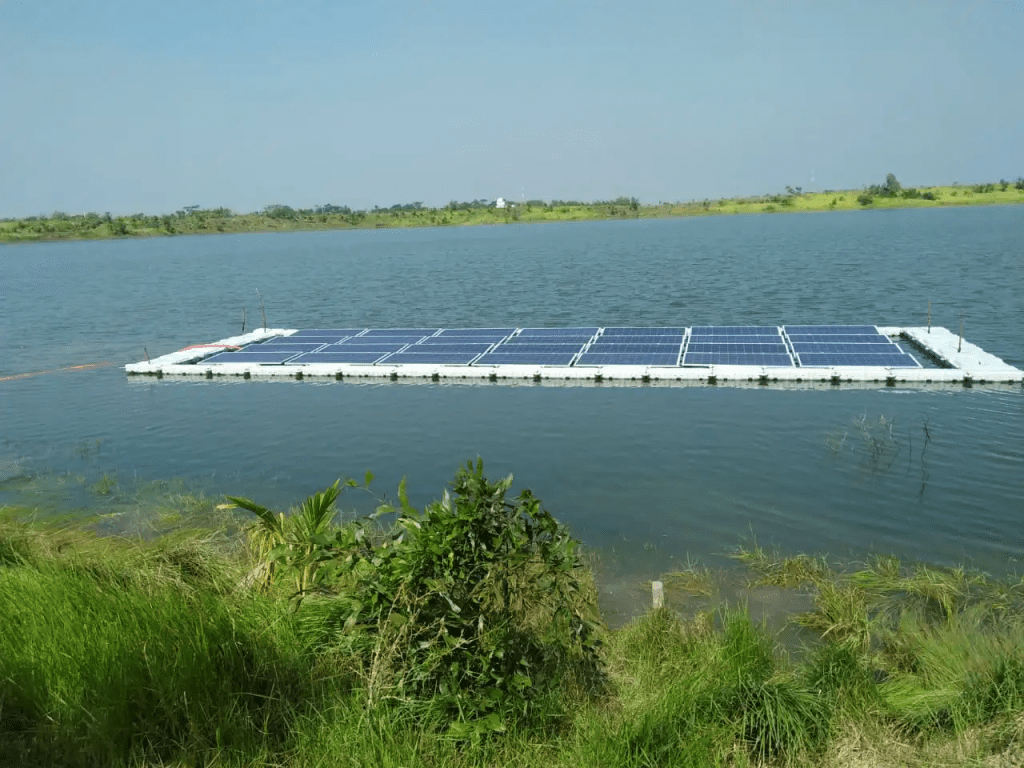
With the aim of tackling the challenge of land scarcity, IDCOL has financed the country’s first large scale floating solar power plant at Bulanpur in Chapainawabganj which was connected to the national grid in May, 2023. The water reservoir is used for fish farming while the electricity generated by the solar panels are sent to a local mill and the national grid. This ingenious use of water bodies for both fish farming and electricity generation paves the way for ensuring both energy and food security in the country.
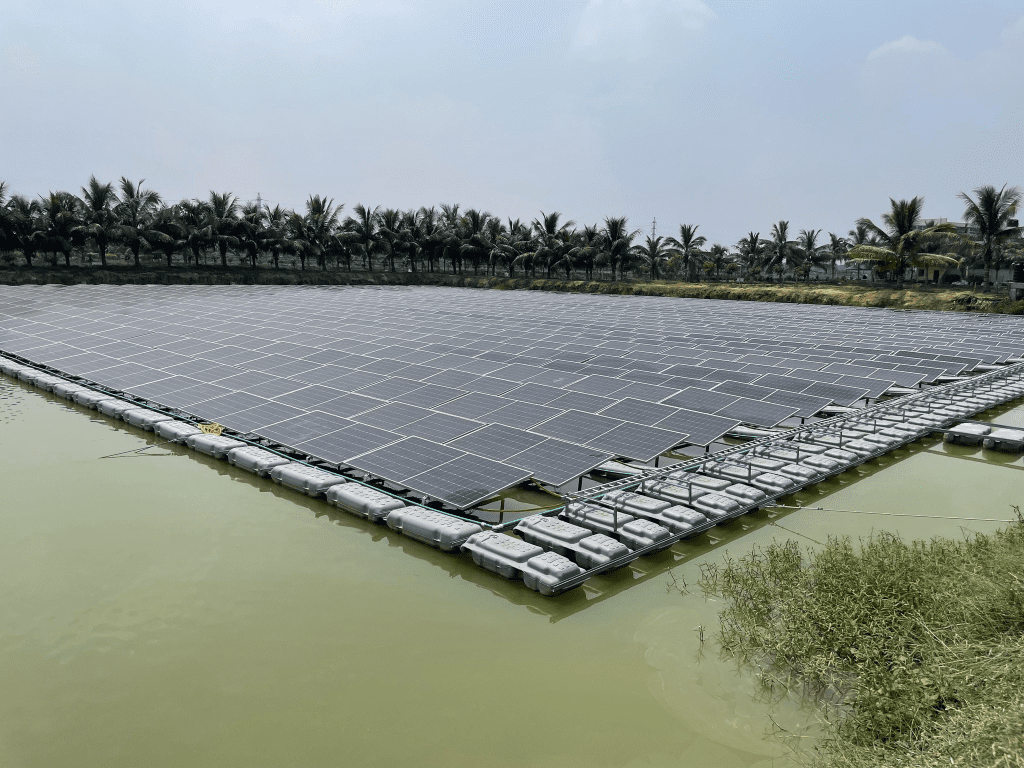
Option #2 | Rooftop Solar Panels
To accelerate the use of renewable energy in the country, GoB made installing rooftop solar power systems mandatory for availing new domestic, commercial and industrial electricity connections from the grid in 2010. This is why so many mid and high rise buildings of Dhaka have solar panels on their roof. But most of them are unused. Most rooftop solar PVs are not connected to the main circuit of the building. In some cases, these are only connected to power common utilities such as security lights, staircase lighting etc.
This happens because the solar PVs were not installed to light our homes. They were installed to comply with the building codes or to get utility connections. Hence, a lack of awareness leads to this wastage of rooftop solar panels in residential and commercial buildings.
Net Metering System
Net Metering System allows consumers to be prosumers if they use their rooftop solar systems. If your solar panel is connected to the grid and you have excess electricity, you can transmit the surplus to the grid and use it when you need it. Bi-directional metering tracks the power flow in two directions – from the solar panels of your rooftop to the grid and from the grid to your home. Your monthly electricity bills are adjusted on the basis of power transmission and usage. Net metering is key because households do not necessarily require an expensive battery storage to store excess electricity which in turn saves both money and electricity.
In 2018, GoB’s Power Division introduced the “Net Metering Guidelines” to utilize the rooftop solar panels. However, after two years, only 1,152 rooftop solar facilities were brought under the net metering system.
Rooftop solar PV has gained huge attention from the country’s RMG factories since the introduction of Net Metering Policy. The incentive of RMG factories behind installing these rooftop solar panels is not just to satiate the demand of foreign buyers. It’s significantly cheaper than the national grid tariff. Solar companies now provide OPEX Model Solar Solution to reduce the cost and risk nearly to zero. Companies go to the factories and bear all the expenses including the installation cost. Companies negotiate a price 10-15% cheaper than the grid with the factory. It’s a win-win situation for both the solar company and factory – where there is no green premium.
GoB has undertaken initiatives to facilitate rooftop solar systems. GoB is considering installing solar panels on rooftops of primary and secondary schools to promote clean energy. IDCOL also provides necessary loan facilities and other support for rooftop solar projects. Up to July 2019, IDCOL has financed 11 rooftop solar projects, 4 of which are operational with a total capacity of 3.07 MW.
SIX recommendations to increase the usage as well as installation of rooftop solar PV-
- The rooftop solar systems should be at least connected to the main circuit of the residential, commercial and industrial buildings to meet the electricity demand for each building.
- The rooftop solar PVs should also be connected to the grid to reduce wastage of excess electricity and earn or save money.
- A nationwide local customer service point for the users can be established by power distribution companies or private entities to bring them under proper guidance. The power distribution companies should also proactively monitor the conditions of the rooftop solar panels in their respective areas.
- The private players have to take up the pivotal role in demonstrating to the users that rooftop solar panels actually work and it’s efficient and reliable and can help to meet their energy needs. In the rural areas, while implementing the SHS program, private players were successful in convincing low-income households to install SHS by demonstrating to them the technology and its benefits.
- According to the current net metering guidelines, only three-phase electricity consumers are eligible for the net metering system. Residential buildings are usually served by a single-phase power supply, while commercial and industrial facilities usually need a three-phase supply. Thus, the policy excludes the largest part of consumers – the single-phase consumers of residential buildings.
The current net metering policy has to be revised and should allow single phase inverters of residential buildings to feed into the grid. The inclusion of residential consumers in the net metering system will provide them an incentive to utilize their rooftop solar systems instead of just installing them for the sake of installing them to get utility connections.
Re-programmable single-phase meters may not be available on the market whereas the three-phase meters are reprogrammable. In that scenario, prgogrammable single-phase meters can be imported and introduced in the domestic market to include residential buildings. - The guidelines also restrict that the output AC capacity of the renewable energy converter can be a maximum of 70% with respect to the consumer’s sanctioned load. The maximum output AC capacity of the installed system cannot be more than 10 MW.
The maximum capacity restriction of 10 MW should be eliminated from the net metering policy. The consumer must be allowed to install 70% of their sanctioned load. Many factories have large size roof capable of generating more than the sanctioned load. Hence, this policy change will allow the factories located in the industrial parks, special economic zones or export processing zones to install solar systems.
Option #3 | Solar Highways, Railways
Construction of Solar highways can lead to an effective utilization of existing infrastructures. South Korea has constructed a 32 km highway between Daejon and Sejong. In that highway, there is a bike lane which is covered with a solar roof panel. Bangladesh can learn lessons from South Korea and build solar highways to increase the use of renewable energy.

Bangladesh has 498 railway stations and over 3,600 km of rail lines. Solar PV can be installed on rooftops of stations and on the edges of the rail lines.
Option #4 | Agrivoltaics
When the same land is used for both agricultural practices and solar panels simultaneously, that is known as ‘Agrivoltaics’. Agrivoltaics enables the use of existing lands by repurposing them for both solar and agricultural activities.
GoB has taken the initiative to grow shade crops on the land under the solar panels in the solar parks. This will enable the country to utilize these lands of solar parks and contribute to the mission of achieving food security. The experiment conducted on the Sirajganj Solar Park to grow shade crops was successful.
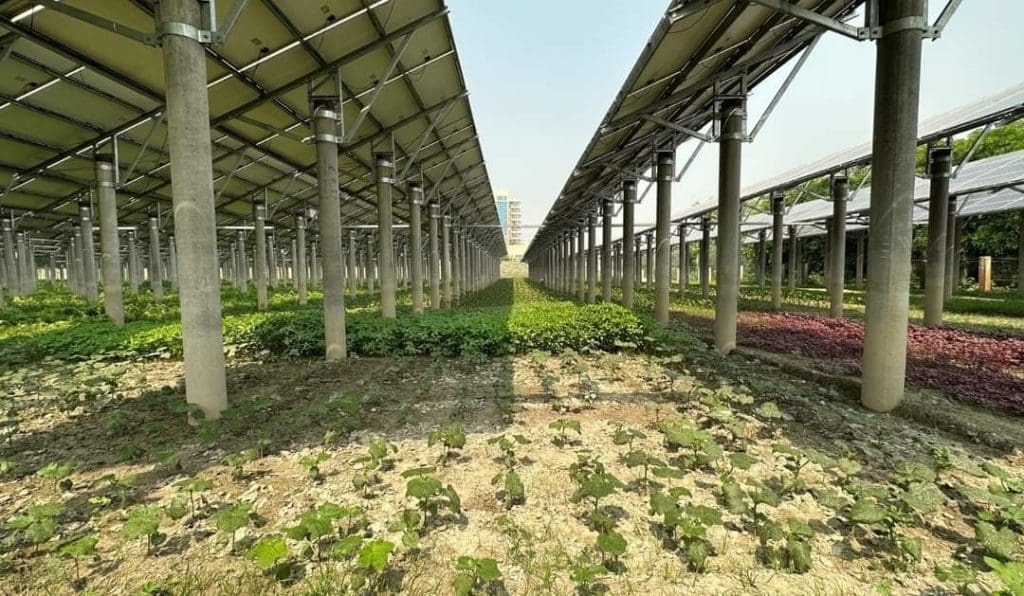
Solar Irrigation
Farmers have to use either diesel-run irrigation pumps or grid electricity for irrigation purposes. Currently, there are 1.3 million diesel-based irrigation pumps in the country used for agro practices. Installation of solar irrigation pumps has been effective in decreasing the dependency on non-renewable energy and grid electricity. So far IDCOL has installed 1,523 solar irrigation pumps to ameliorate the sufferings of farmers. For instance, In Dinajpur, farmers now irrigate their paddy fields with solar irrigation pumps. Power generated by the solar pumps is also utilized for water purification, cold storage for mushrooms and brick-making. Even farmers utilize the shady spaces behind the large solar panels to keep poultry farms. In the night, the excess energy is used to power solar lights to run classes for women in sheds to improve their literacy. In this way, solar power has become a one-stop-solution for rural Bangladesh.
Solar Mini Grids
A small grid which generates electricity of a few kW to 10 MW is called a mini grid. In areas where it’s difficult to expand the national grid, solar mini grids can be used to generate electricity. Till now, IDCOL has installed 26 solar mini grids with cumulative capacity of 5 MW which provided electricity to around 16,000 beneficiaries in rural Bangladesh. In the Monpura island, two mini grids are powering 1,199 households, 684 shops and 41 institutions improving the quality of life in the island.
Solar Powered Charging Stations
Bangladesh is expected to witness a massive rise in the number of electric vehicles which will necessitate electrification of the transport sector. To reduce the burden on the national grid, Bangladesh has implemented solar-powered charging stations in different places of the country. A charging infrastructure is crucial for the extensive utilization of electric vehicles. Therefore, 14 solar charging stations with a cumulative capacity of 0.282 MWp have been installed across the country. The country is already formulating guidelines for EV charging stations. The batteries in the electric vehicles serve the purpose of storage. A collectivization of these EV batteries will develop a vehicle to grid (V2G) system in future.
Further Areas of Intervention
- Even though GoB has introduced numerous policy frameworks, the problem is they originate from different government agencies and thus, lack coordination. The major issue with all the strategic documents of the government is they promote the implementation of different renewable energy projects with different targets in the upcoming years.
- The future growth of renewables in the country will necessitate millions, if not billions, of dollars’ worth of financing. Only relying on IDCOL for most of the financing won’t suffice the growing demand for renewable energy. The entire financial sector must grow in the direction of facilitating renewable energy technologies. Thus, commercial banks and other financial institutions will have to take up the lead and explore the opportunities of financing renewables.
Bangladesh Bank has to be more proactive and increase the efficacy of its initiatives such as Green Funds. Since the rate is lower than the commercial banks’ own offered rates, the banks are often reluctant to provide this fund. Therefore, BB has to actively monitor the deployment of the money to secure the direction of the funds into solar and other renewable energy projects. - As an alternative to conventional peaking power plants, storage batteries such as Lithium-Ion and Lead Acid batteries can be used to store energy during the daytime and deliver during the peak hours. The financial institutions have to be proactive in financing this initiative. It is noteworthy that Bangladesh is now venturing into lithium battery production.
- Currently, Bangladesh imposes 26%, 38%, and 58% import duties on solar panels, inverters and solar DC cables respectively. Import duties on solar equipment can be reduced or waived to make solar technology more accessible and affordable in the country.
- The Renewable Purchase Obligation (RPO) is a mechanism by which the Electricity Regulatory Commissions oblige entities to purchase a certain percentage of power from renewable energy sources. This framework needs to be introduced in the renewable energy policy.
About the Author

Shah Adaan Uzzaman is the Blog Administrator at The Confluence. A former Bangladesh Television Debate Champion and winner of several policy & debate competitions, he is currently a student of IBA, University of Dhaka.

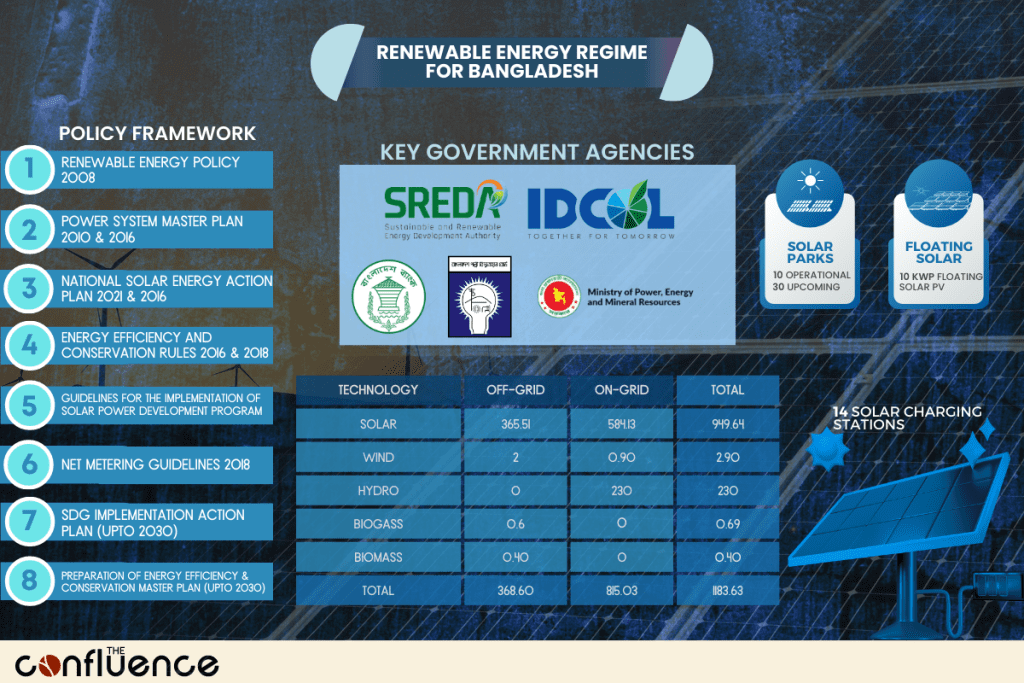

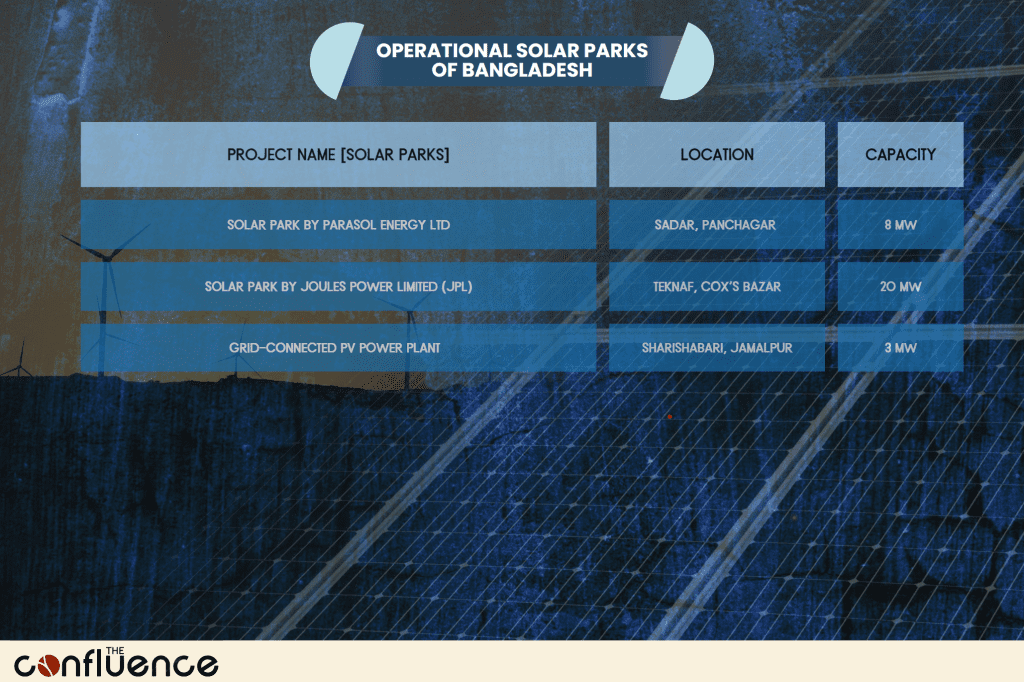
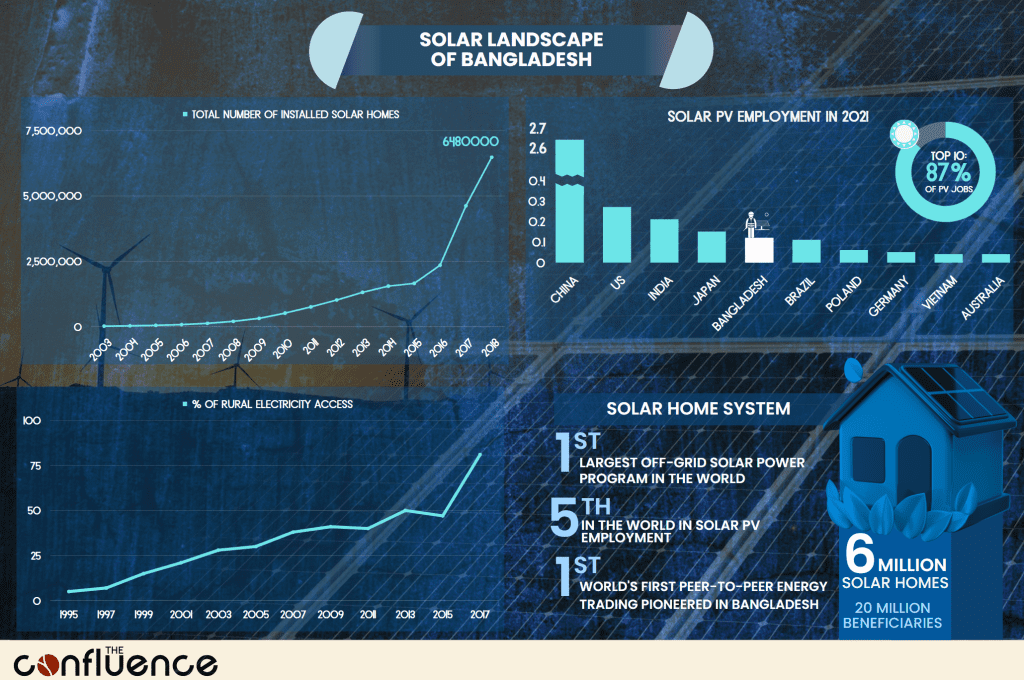
2 comments
[…] equal scope of generating green power. In case of Bangladesh, we rely on sources such as biomass, solar, wind, and tidal power to minimize dependency on traditional fossil fuels. Bangladesh has planned […]
[…] holds substantial potential for generating electricity from renewable energy sources. Solar power, in particular, has emerged as a commercially viable option. Beyond solar, other renewable sources […]